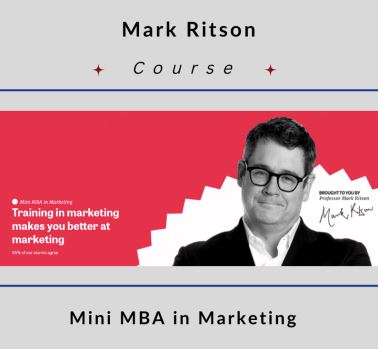Mark Ritson – Mini MBA in Marketing
$89.00
- Description
Description
Mark Ritson – Mini MBA in Marketing
Become the best marketer you can be.
The Mini MBA in Marketing is an MBA level, CPD accredited course that gives you the tools and expertise to supercharge your career. On-demand modules based on Mark Ritson’s award winning MBA teaching form the basis for applied, world class learning.
Designed for marketers of all backgrounds, nationalities and educational levels, over 90% of our alumni complete the course feeling more inspired, confident and effective as a result of taking the Mini MBA in Marketing.
Here’s what you’ll get in Mini MBA in Marketing
Module 1: Market Orientation
customer focus / business culture / predictive marketing
Getting your head on straight before we even begin is fundamentally important. Start to think from the vantage point of the customer first and not the products, communications, and sales (that come further down the line).
It sounds simple. It’s not. Many well-known companies have failed this first step. Get it right and you throw open the door into the wide world of marketing and start your marketing journey.
Module 2: Market Research
research design / qualitative methods / quantitative methods / backwards market research
If Market Orientation is about digging deeper into your customer needs, Market Research is about filling the hole with insights and lessons from the market.
It’s about choosing the right research methodologies and combining them together to get a full picture of who your customer really is, what they want and how they behave.
Module 3: Segmentation
market mapping /demographics / firmographics / behavioural
All of your customers are different. This poses an important question. Do you treat the whole market the same or try and give individual customers exactly what they want?
Truth is, only selecting one won’t set the marketing world alight.
Learn how to pattern the market based on our insights from Module 2 and define the distinct groups you do, and equally crucial, do not want to target.
Module 4: Targeting
strategic decisions / mass marketing / target segment portraits / targeting criteria
At this stage, it’s time to get the cross hairs out for Targeting as our first advance into strategy.
Choosing who do we target and, crucially, who do we not target is the first fundamental of strategy. It will determine yours and your business’ success.
Module 5: Positioning
brand position / articulation / disruptive execution / perceptual maps
This is where we define what our business stands for, what we want it to represent, and what we want it to be for our target segment(s).
We need to think about three things; what do they want, what can we offer, and who and what are our competitors offering. This will help us find the correct position for our products to be successful.
Module 6: Objectives
Purchase funnel / The right objectives / Strategic decision making
What are our objectives, top-of-funnel, bottom-of-funnel, awareness, preference, repeat purchase?
What are the levers we are going to pull for growth and how do we know what success looks like? This is a crucial decision making moment for marketing success and a central piece of your strategy.
Module 7: Product
product creation /product assessment / NPS scores
Now we have defined and understood everything about our strategy we need to make sure that the product we are selling fits into it perfectly.
So, how do we listen to the customer and design, develop or augment our products so they exactly fulfil the promises we have made to the market?
Module 8: Price
Price settings / Using quantitative models to set a price / Discounting and price wars
There are few more important concepts than pricing. Yet it is also staggering how many so-called marketers neglect it.
We can all sell, but doing so at a level that achieves a sustainable profit is an entirely different matter. Learn how price should be calculated, set and then communicated. Understanding the power of price is one of the key lessons of marketing.
Module 9: Integrated Marketing Communications
The S curve / Profitability matrix / Price setting / Elasticity
After all the work done and positioning ourselves for success, it’s time to think about tactics.
How do we communicate about our product or service to the marketplace? What combination of traditional or digital channels will help us create that most important of things, a successful marketing campaign.
Module 10: Distribution
Omnichannel / Direct vs indirect channel models / D2C sector
Place, the final “P”. How do we get our product from the factory to the customer out in the market?
Understanding the advantages and disadvantages of direct and indirect distribution and their link to the wider business strategy is crucial to business success.
Related Products
-
-96%
 Add to cartQuick View
Add to cartQuick View -
-99%
 Add to cartQuick View
Add to cartQuick View






